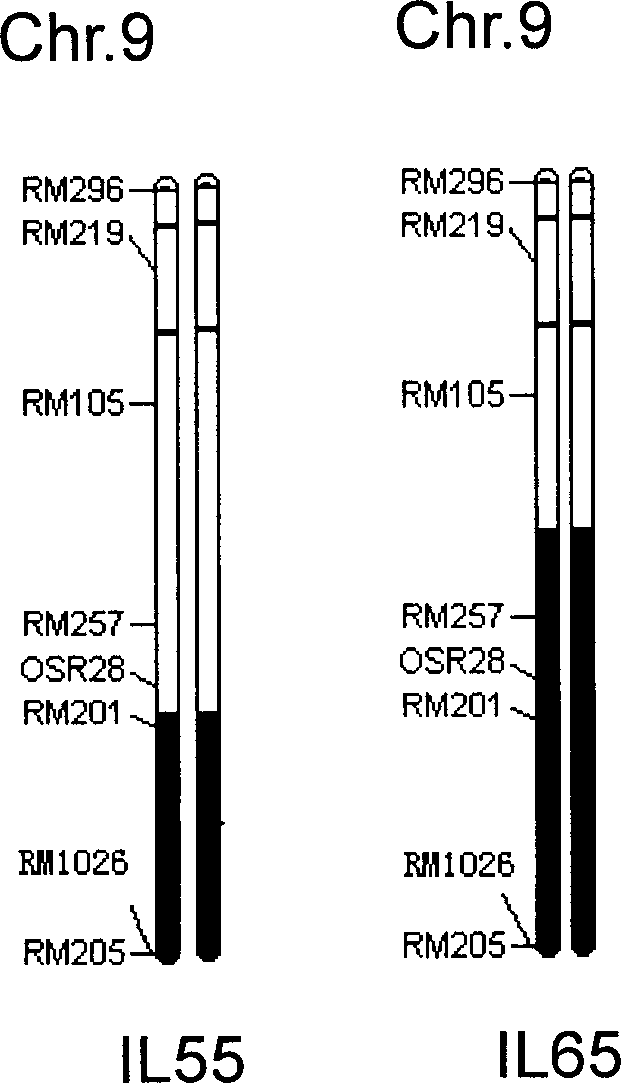Gene adjusting and controlling rice tillering angle and its coded protein and use
A rice and angle technology, applied in the fields of application, genetic engineering, plant genetic improvement, etc., can solve the problems of rice yield reduction, plant growth cramped, group photosynthetic efficiency reduction, etc., and achieve the effect of wide application and market prospects
- Summary
- Abstract
- Description
- Claims
- Application Information
AI Technical Summary
Problems solved by technology
Method used
Image
Examples
Embodiment 1
[0043] Example 1. Obtaining the transcription factor gene compact1 that regulates rice tillering angle
[0044] Rice varieties: Asominori, IR24, Dongxiang wild rice, Yuanjiang wild rice, Teqing, 9311, Guichao 2, E32, Nipponbare, Qiuguang, Shuiyuan 349 (all from the Seed Bank of the Rice Group, College of Agronomy and Biotechnology, China Agricultural University) .
[0045] Using Japonica rice Asominori as the donor and Indica rice IR24 as the recipient, a high-generation backcross population (BC3F4) was constructed, from which a compact plant type line with a small tiller angle was found. One of the plants was selected to be compact and only compared with the tiller angle phenotype. There is a difference in IR24 line IL55 (The comparison chart of the compact plant type IL55 and the plant type loose line IR24 is shown in figure 1 ), and crossed it with IR24 to construct an F2 segregating population containing 12,000 individual plants. In this F2 population, the ratio of individual...
Embodiment 2
[0046] Example 2. Obtaining of com1 transgenic rice and its PCR detection
[0047] 1. Construction of com1 plant expression vector
[0048] Design primers based on the full-length cDNA sequence of com1 of IR24, and introduce restriction endonuclease Sma I and Spe I recognition sites and protective bases at both ends of the primers. The primer sequences are as follows:
[0049] CDS-P-ATG: 5’- TGCCCCGGG CGTACTGTCTGGCTTTCTCTTCTGGT-3' (underlined bases are the recognition site of restriction endonuclease Sma I and protection bases);
[0050] CDS-P-TGA: 5’- CACTAGT AGGACTATTCTTCATCACTGGCG-3' (underlined bases are the recognition site of restriction endonuclease Spe I and protected bases)
[0051] Use TRIZOL reagent to extract RNA from the leaves of IR24 at the seedling stage (three leaves and one heart), use this RNA as a template, and use MMLV reverse transcriptase to perform reverse transcription to obtain cDNA, and then use this cDNA as a template with primers CDS-P-ATG Under the g...
PUM
 Login to View More
Login to View More Abstract
Description
Claims
Application Information
 Login to View More
Login to View More - R&D
- Intellectual Property
- Life Sciences
- Materials
- Tech Scout
- Unparalleled Data Quality
- Higher Quality Content
- 60% Fewer Hallucinations
Browse by: Latest US Patents, China's latest patents, Technical Efficacy Thesaurus, Application Domain, Technology Topic, Popular Technical Reports.
© 2025 PatSnap. All rights reserved.Legal|Privacy policy|Modern Slavery Act Transparency Statement|Sitemap|About US| Contact US: help@patsnap.com



